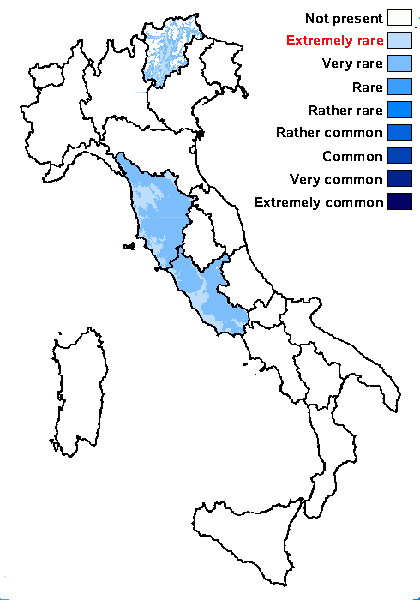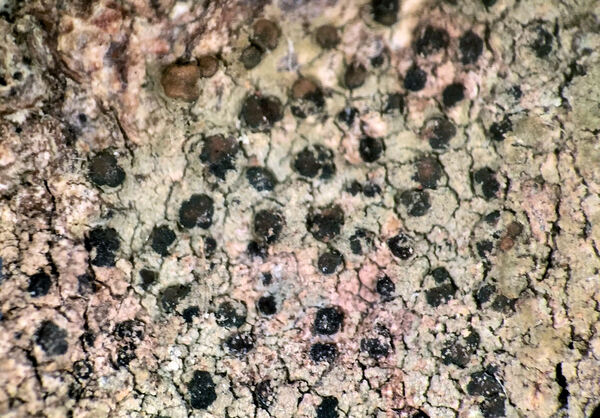Lecidella albida Hafellner
Stapfia, 76: 153, 2001.
Synonyms: Lecidea alba Schleich. non (Roth.) Flörke; Lecidella alba auct.
Distribution: N - TAA. C - Tosc, Laz.
Description: Thallus crustose, episubstratic, whitish to grey- or yellowish green, sorediate, often delimited by a dark prothallus from neighbouting species. Soralia at first punctiform, later confluent and irregular in outline, finally often forming a more or less continuous sorediate crust; soredia whitish or grey- yellowish-green, farinose, 20-40 μm wide. Apothecia very rare, lecideine, 0.2-0.5 mm across, with a dark brown to black, mostly flat disc and a concolorous, slightly raised, persistent proper margin. Proper exciple brownish; epithecium blue-grey to brown-black, with crystals; hymenium colourless, 60-70 μm high, not inspersed with oil droplets; paraphyses rather coherent in water, more easily made free in K, mostly simple, the apical cells markedly swollen, with a dark cap; hypothecium colourless to pale yellowish brown; epithecium, hymenium and hypothecium with large (to 10 μm) blue crystals reacting N+ red. Asci 8-spored, clavate, with an intensely K/I+ blue tholus penetrated by a faintly amyloid, broadly cylindrical axial mass, and a poorly developed ocular chamber, the wall K/I-, surrounded by a K/I+ blue outer layer, approaching the Lecanora-type. Ascospores 1-celled, hyaline, broadly ellipsoid, (9-)15-18 x (6-)10-12 μm, often poorly developed. Photobiont chlorococcoid. Spot tests: thallus K+ yellow, C-, KC-, P- or P+ pale yellow (reactions better visible in thick microscopic sections), UV365+ dull orange. Chemistry: thallus with atranorin, thiophanic acid, capistratone and arthothelin. Note: a mainly central European species, growing on the smooth bark of more or less isolated individuals of acid-barked deciduous, rarely coniferous trees in non-eutrophicated, rather humid situations, mostly below the subalpine belt. For further information see Dietrich (2007).
Growth form: Crustose
Substrata: bark
Photobiont: green algae other than Trentepohlia
Reproductive strategy: mainly sexual
Commonnes-rarity: (info)
Alpine belt: absent
Subalpine belt: absent
Oromediterranean belt: absent
Montane belt: very rare
Submediterranean belt: extremely rare
Padanian area: absent
Humid submediterranean belt: very rare
Humid mediterranean belt: extremely rare
Dry mediterranean belt: absent

Predictive model
Herbarium samples
Growth form: Crustose
Substrata: bark
Photobiont: green algae other than Trentepohlia
Reproductive strategy: mainly sexual
Commonnes-rarity: (info)
Alpine belt: absent
Subalpine belt: absent
Oromediterranean belt: absent
Montane belt: very rare
Submediterranean belt: extremely rare
Padanian area: absent
Humid submediterranean belt: very rare
Humid mediterranean belt: extremely rare
Dry mediterranean belt: absent

Predictive model
| Herbarium samples |
 INDEX FUNGORUM
INDEX FUNGORUM
 GBIF
GBIF
 DOLICHENS
DOLICHENS



